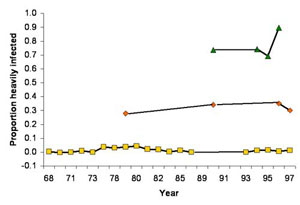Why Migration Might Occur
Monarch Cold Toleranceand Parasites
Why do butterflies migrate? Why do they move across thousands of miles to Mexico to live for the winter?
Many parts of a butterfly’s livelihood change as winter approaches. Temperatures drop and butterflies don’t handle the cold well. In a various number of ways the cold wreaks havoc on the monarch’s fitness. Their food, home, and their offspring all begin to die in the winter months. Monarch larvae do not develop well in temperatures lower than 12°C or 54 degrees fahrenheit.1 The development a larvae is supposed to undergo becomes impossible and the larvae die at lower temperatures. Milkweed, the major food source and the site monarchs lay eggs, also can wither and become a poor source of food and protection. So, the butterfly leaves its prior home and moves towards Mexico, where the temperatures will be far more ideal for it to survive, eat its milkweed, and reproduce.

Photo: University of Georgia. Yellow (~8%) represents the Eastern migratory population of Monarchs. Red (~30%) is the Western Migratory monarchs and green (~70%) is non-mirgatory southern populations. (The proportion of the population effected by parasites is negatively correlated with the distance traveled by the population.)
Avoiding the deadly cold isn’t the only benefit to flying to mexico for the winter. By undergoing migration monarch populations can better survive the threat of parasites. Monarchs are often hosts to Ophryocystis elektroscirrha, a protozoan parasite that infects monarchs in every population found in the wild. The protozoan infects its host as a larvae, when it consumes spores on milkweed, and then as the larave becomes an adult the parasite multiplies and leaves spores on the emerging adult monarch, to then spread the spores for other larvae to eat.
Citations:
1. Malcolm, S. B. et al. “Monarch Butterfly Voltinism: Effects of Temperature Constraints at Different Latitudes.” Oikos, vol. 49, no. 1, 1987, pp. 77–82. www.jstor.org/stable/3565556.
2. Bartel, R., Oberhauser, K., de Roode, J., & Altizer, S. (2011). Monarch butterfly migration and parasite transmission in eastern North America. Ecology, 92(2), 342-351. doi:10.1890/10-0489.